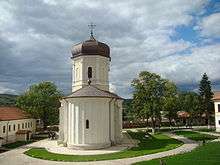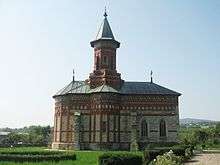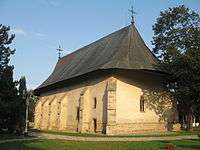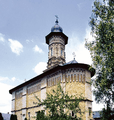Moldavian style
Moldovenesc style or Moldavian architectural style is a type of architecture developed in Moldavia during the 14th through 19th centuries.
The period of maximum flowering of this style was in the period of Stephen III of Moldavia. The Moldavian monasteries which belongs to the UNESCO heritage are made in this style.
See also
Gallery
 Putna Monastery in Suceava County
Putna Monastery in Suceava County Neamț Monastery in Neamț County
Neamț Monastery in Neamț County
 Căpriana monastery in Strășeni District, Moldova
Căpriana monastery in Strășeni District, Moldova- Bistrița Monastery in Neamț County
 St. George Church in Hârlău
St. George Church in Hârlău Stephen III of Moldavia's Tower in Piatra Neamţ
Stephen III of Moldavia's Tower in Piatra Neamţ- Three Hierarchs Monastery detail, in Iaşi
 Bogdana Monastery in Rădăuţi
Bogdana Monastery in Rădăuţi Dobrovăţ Monastery in Iaşi County
Dobrovăţ Monastery in Iaşi County Văratec Monastery in Neamț County
Văratec Monastery in Neamț County- Galata Monastery in Iaşi
 Bell Tower, Popăuți Monastery in Botoşani
Bell Tower, Popăuți Monastery in Botoşani Cetățuia Monastery in Iaşi
Cetățuia Monastery in Iaşi Sfânta Paraschiva Cathedral in Roman
Sfânta Paraschiva Cathedral in Roman Socola Monastery in Iaşi
Socola Monastery in Iaşi Sihăstria Monastery in Neamț County
Sihăstria Monastery in Neamț County Dragomirna Monastery in Suceava County
Dragomirna Monastery in Suceava County Secu Monastery in Neamț County
Secu Monastery in Neamț County Hadâmbu Monastery in Iaşi County
Hadâmbu Monastery in Iaşi County Orthodox Cathedral in Timișoara is an example of Neo-Moldavian style
Orthodox Cathedral in Timișoara is an example of Neo-Moldavian style
External links
| Wikimedia Commons has media related to Buildings in Moldavia. |
This article is issued from Wikipedia - version of the 11/29/2014. The text is available under the Creative Commons Attribution/Share Alike but additional terms may apply for the media files.